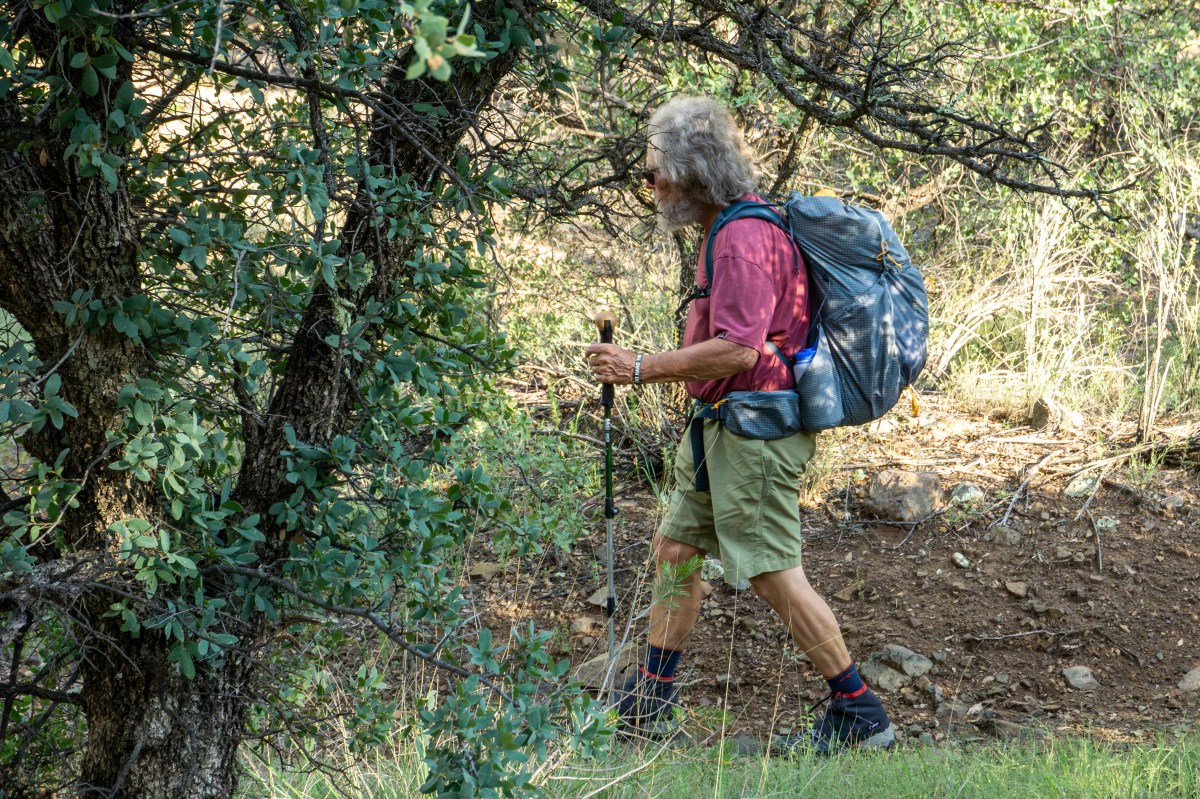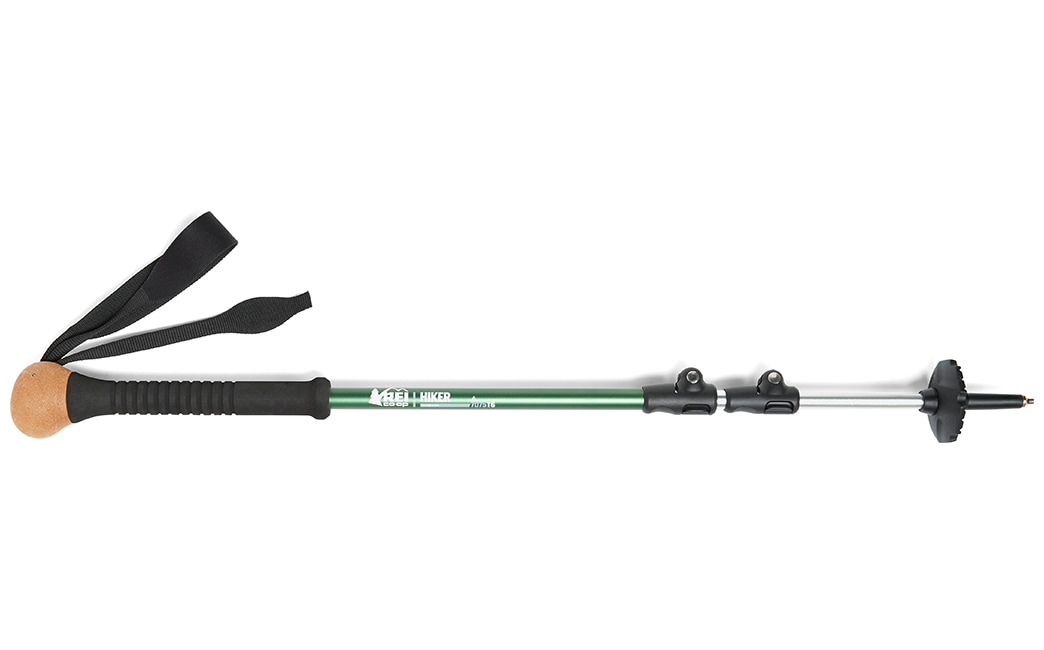
My backpacking career has taken me through a whiteout blizzard at 12,000 feet in the Colorado Rockies; mosquito-infested jungle during a monsoonal deluge in Honduras; and 120°F heat in the bottom of Mexico’s Copper Canyon—but this was the worst weather I had ever experienced. I was supposed to embark upon Iceland’s challenging Fimmvörðuháls, a popular mountain pass in the southern highlands. In anticipation of a long, arduous trek—15 miles, with almost 4,000 feet of vertical ascent and descent—I set the alarm for 4:30 am, waking early to make final preparations and grabbing one piece of gear that’s aided me in so many of my adventures: my REI Co-op Hiker Power Lock Staff. And I’m glad I did. Before I even exited my tent, it began to rain. By the time I hoisted my pack, it was a downpour, the wind had picked up and the temperature had dropped so much that my arthritic fingers began to stiffen.
I had completed the famed 35-mile Laugavegur Trail the previous day, and the Fimmvörðuháls—which is essentially an extension of the Laugavegur—was meant to be the icing on my Icelandic cake. Despite worsening weather, I decided to forge ahead. There was no time to wait out the storm: My wife was impatiently awaiting my return from the trail so we could explore Iceland’s famous Ring Road in a rented camper van.
Two hours in, I faced perhaps the most dangerous section of the Fimmvörðuháls: An exposed knife edge with tread no more than a foot wide and unsurvivable several-thousand-foot drop-offs on both sides. The wind had reached gale force, the rain was starting to mix with snow and ice was forming on the rock-studded trail. I struggled to stand upright. With one hand clutching my Hiker Power Lock staff, I managed to inch along the spine without injury—just a churning stomach and severely elevated heart rate. Were it not for that staff, I would have turned around. Or the wind would have blown me off the knife edge. Instead, the pole helped me brace myself against oblivion.
Farther along the trail, with the weather having deteriorated from dismal to horrific, I passed through several more exposed sections and crossed numerous steep snow and ice fields where I again relied on my Hiker Power Lock staff for propulsion, balance and, most importantly, confidence.
When I reached a safer checkpoint, I let out a sigh of relief and kissed my staff atop its rounded cork knob. I thanked it for, once again, helping me reach safety.

Some might wonder why I didn’t utilize a pair of trekking poles, like most every other hiker on the planet. Well, I’m simultaneously an anomaly and an anachronism: a lifelong trail tripod, a man who uses a single pole.
Despite the fact that I’ve fully embraced recent technological advancements in backpacking equipage when appropriate—mainly the evolution of ultralight gear—I remain at heart “old-school.” My footwear stash includes a pair of heavy leather hiking boots, which I don mainly for effect when going out for beers. I own an external-frame Kelty Tioga pack, which I use for heavy loads and when I want to commune with the spirit of the late backpacking icon and author Colin Fletcher. And, until recently, I brought with me to the trail a wooden hiking stick, procured many years ago from the darkest corner of a dusty antique emporium. It’s impossible to guess how many miles that stick and I have hiked together.
In my part of the world, a lot of people—mostly, like me, of a certain age—still use hiking sticks, and I’ve enjoyed many pleasant trailside conversations with fellow hikers about theirs. Their origin stories, what kind of wood they were made of, where they have been.
Eventually, I had to retire my wooden stick. Once 59 inches high, it had eroded by more than half a foot and developed a crack that rendered it unsafe to use. At the same time, I began visiting farther-flung trails that required air travel and, sadly, long wooden hiking sticks are not considered suitable carry-on baggage. It wouldn’t have survived being stowed in the belly of a plane under mountains of luggage.
None of the obvious alternatives—hiking without a stick, using a pair of trekking poles, or buying a pair of trekking poles and using only one—appealed to me. Despondently, I thought I might need to resign myself to hiking destinations that didn’t require flying.
Then, while strolling through the REI in Tucson, Arizona, I came upon the Hiker Power Lock Staff. It was like a bright heavenly light had suddenly shined down upon the aisle in which I was standing. I couldn’t pull my wallet out fast enough. The Hiker Power Lock Staff and I have been joined at the hip(strap) ever since. Now, when I fly, I collapse it down, stash it inside my pack and send it into the belly of the aeronautical beast. (Metal poles with pointy tips are not allowed in the main cabin, for obvious reasons.)
After many years and many miles of using a hiking stick, I am used to a single aid. I’ve tried trekking poles but they felt too awkward. I ended up paying more attention to pole placement than I did foot placement. While I understand there will be indignant scoffs, I consider the staff to be more versatile than a pair of poles.
Another main attraction to using a single staff is having a set of unencumbered hands. I don’t have to de-couple to wipe my nose or pull a snack from my hipbelt pocket.
I recently completed a long traverse of the massive wilderness area that lies close to my home in New Mexico. Midway through, I spontaneously diverted from the system trail I had been following and bushwhacked up a creek bed. The canyon boxed up tight and I was forced to negotiate series after series of house-size boulders that jammed my route, requiring gymnastics that would have been more complicated with trekking poles. I would have had to move both poles to one hand or emove my pack (difficult, given that I was, for the most part, standing in waist-deep water) to stash one or both of them.
Instead, with the Hiker Power Lock Staff helping to maintain my balance, I had a free hand that I could use to grip the rock faces I was ascending.

There are additional features that appeal to me. The REI staff’s padded grip is 8 inches long, making it easy to reposition my hand as situations merit. In this regard, it mimics one of the main advantages in using a wooden hiking stick. (Here I should note that while the Hiker Power Lock Staff has wrist straps, I choose to not use them. Again, personal preference.) With a fully extended length of 55 inches, the staff also has a longer maximum length than most trekking poles, adding to its versatility, especially on extremely steep descents.
My trekking-pole-using wife, who is rarely on the trail without photographic equipment, enjoys that the cork cap of my Hiker Power Lock Staff can be removed, exposing a threaded camera mount that turns the staff into a functional monopod. (After she snaps a few shots, I make her give me back my staff.)
At 10.2 ounces, the REI Co-op Hiker Power Lock Staff is light. Its collapsed length of 26 inches makes it easy to stow on both day packs and backpacks for times when a blemish-free trail means a staff isn’t required, or when both hands are needed for scrambling. Its external lever locks are bomber. I’ve tried to make those locks fail by placing my entire body upper weight upon them and they have held fast—a good feature when you’re depending upon the staff to help you cross a raging river or keep you from plummeting off a cliff in Iceland.
There’s no doubt that my Hiker Power Lock Staff will never match the old-school aesthetic of my beloved wooden hiking stick, which I keep parked in the corner of my office to remind me of the many adventures we once shared. Future adventures, though, will take place with my staff tightly held in one hand, while the other hand remains free to wipe my nose and retrieve snacks.
Related reading
The post Gear I Hold Dear: My REI Co-op Hiker Power Lock Staff appeared first on Uncommon Path – An REI Co-op Publication.

